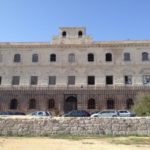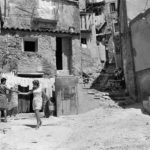The tragic story of
Maria di Sicilia,
a queen without a crown
January 23rd, 1387: an adventurous and fairy liberation plan involved Guglielmo Raimondo Moncada and the daughter of King Federico IV, Maria. She was been imprisoned at the Ursino Castle by the greedy vicar Artale, who did not accept her as the legitimate heir to the throne. Centuries later, we retrace the story of this noble and courageous lady who spent all her life struggling to play a role in society
The Ursino Castle is the main attraction of Piazza Federico II di Svevia. The volcanic eruption that destroyed Catania in 1969 just changed its morphology, but not its imposing structure that still fascinates citizens and tourists. Its walls tell a thousand stories, just like the engravings of the prisoners or the chandeliers reminiscent of a once jewish borough. On July 2nd, 1363 Mary of Sicily, a young queen with an adventurous life and a tragic destiny, was born there. She was the daughter of Constance of Aragon and King Federico IV (also born in Catania) and their only heir, as soon after her mother died prematurely and was succeeded by Antonia del Balzo, cousin of Queen Giovanna I of Naples. Federico died in Messina in July 1377, leaving the kingdom in chaos: since not even Antonia had had a long-awaited son, the legitimate heir was a woman, Maria. Truth to be told, Frederico did have a son, Guglielmo, even if he was an illegitimate child who was then entrusted with the kingdom of Malta. On the other hand, Maria was not only a woman, but also a very young girl. For this reason, right before he died, Federico left his royal powers and the protection of his daughter to four vicars: Artale Aragona, Guglielmo Perrotta, Francesco Ventimiglia and Manfredi Chiaramonte.
AN ANCIENT RAPUNZEL. The fate of Maria, already marked by the death of her loved ones, was full of many other difficulties. In the first place, she had to submit to the will of four different regents who wanted power each for themselves. Then she endured the irritation of Peter IV, king of Spain, who wanted the kingdom of Sicily back under the direct control of the crown. Moreover, Artale, who had already imposed his dominion over Catania with the help his father Blasco, was planning to give Maria in marriage to Gian Galeazzo Visconti, the famous lord of Milan, so that he would become the undisputed master in town. Like an ancient Rapunzel, Maria was then locked up in the Ursino Castle, where she lived in a state of semi-liberty. However, the Catalans had not lost hope: Pietro did not want to lose such a fertile land and Guglielmo Raimondo Moncada, Count of Agosta, came to his aid in order to regain the power he had lost after the arrival of the four vicars.
THE RESCUE OF MARIA. Their plan was carried out on January 23rd, 1387. At first, the young woman was taken to the castle of Augusta, which was soon besieged by Artale. At that point Giovanni brought her to the castle of Licata, where he entrusted her to the emissaries of King Pietro. As Licata was under siege too, Maria was transferred to Sardinia and then to Barcelona, where she was entrusted to the care of an aunt. Locked there and left without a kingdom, she finally decided to give in to the requests of her Spanish relatives and married Martino known as The Young, son of King Pietro IV. After being a queen she became the consort of the new king of Sicily and was crowned with her husband in the cathedral of Palermo in 1392. Still, her problems were not over yet: the vicars had not accepted the new political order of the island and decided to stipulate the Castronovo’s oath, with which they promised to regain their power. Anyway, probably the city of Catania did not take part in those battles, because after the peace of 1398 the city was rewarded for its loyalty to the crown.
A TRAGIC DESTINY. On November 17th, 1398, at the Ursino Castle, Maria gave birth to the heir to the throne despite her precarious health conditions. She would have liked to call the baby Federico as a sign of good luck and in order to emphasize her Swabian ancestry, but her husband preferred the Aragonese name Pietro, in honor of his father. Unfortunately, the child did not live long and died right inside the castle where he was born on November 8th, 1400. It is said that he was killed by a spear in the head during a joust. Torn by the death of her son, Maria followed him on May 25th, 1401, also because of the plague that had spread to Catania. Her destiny was to be Queen of Sicily and the last true heir of her lineage in the island where she was born, as things do not always go as they should, especially for women. Sicily would have seen its redemption only with Queen Bianca of Navarra, the second wife of King Martino, who would reign wisely until she was deprived of her power.
Translated by Eva Luna Mascolino



